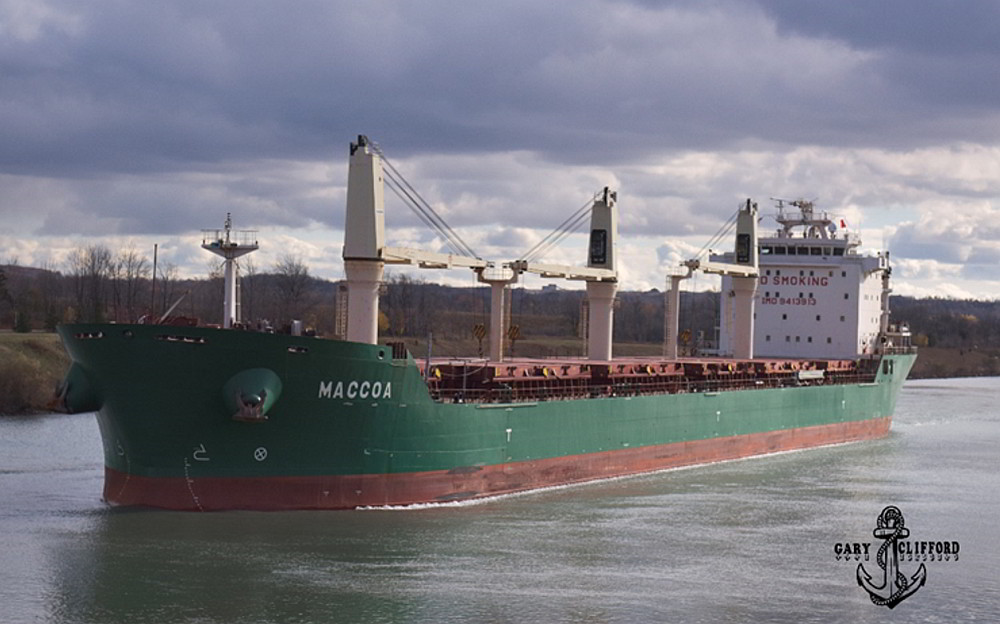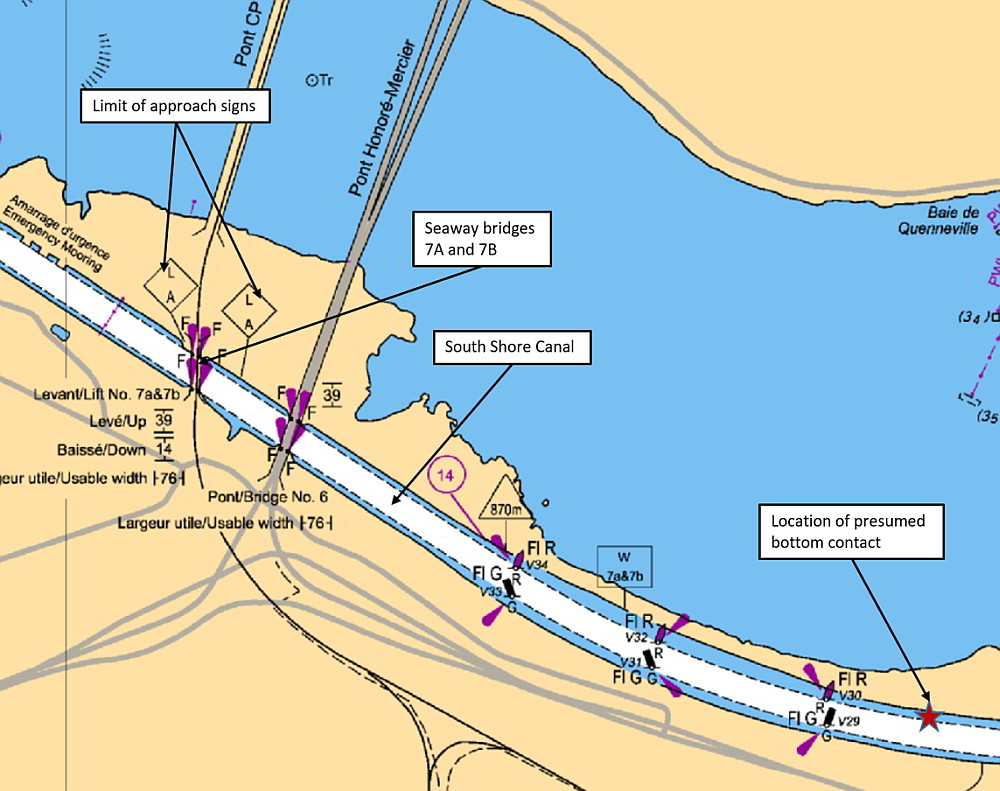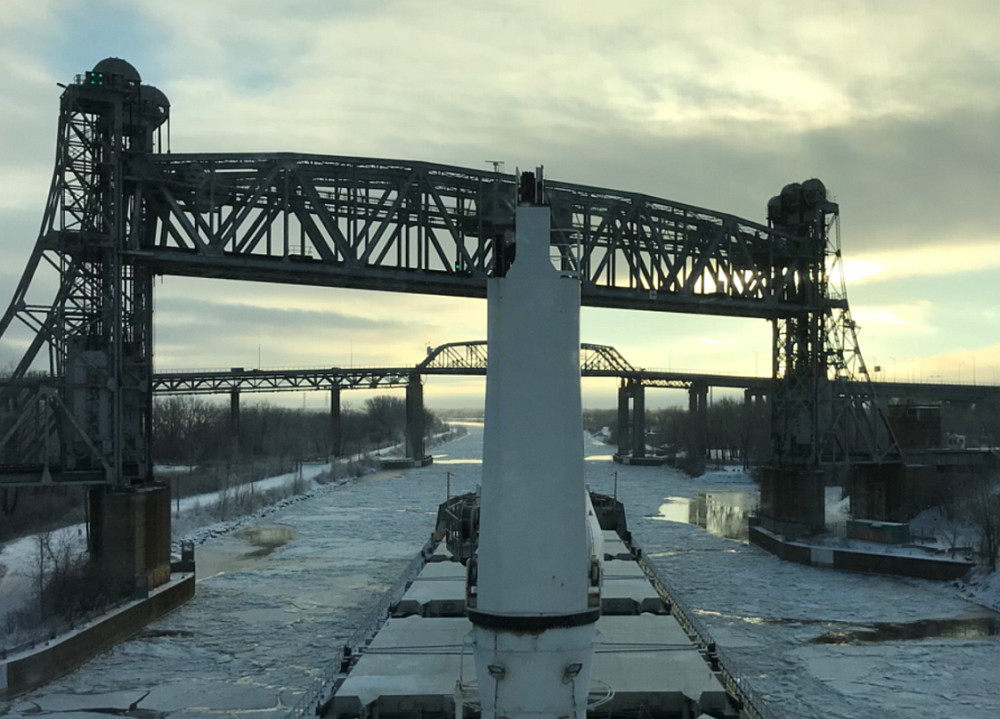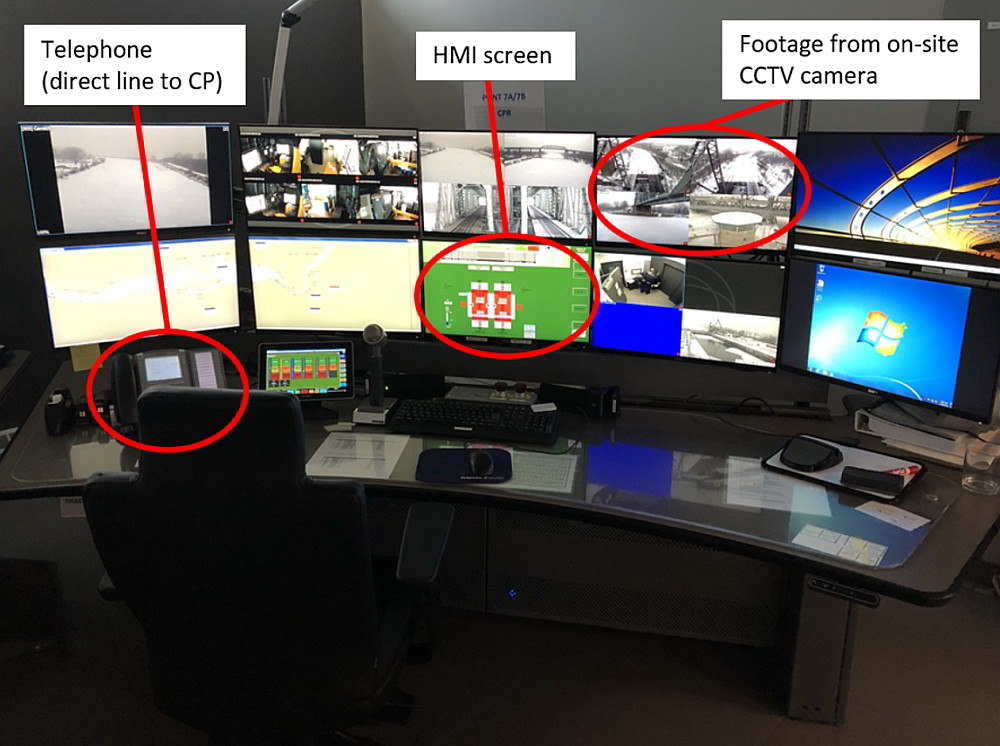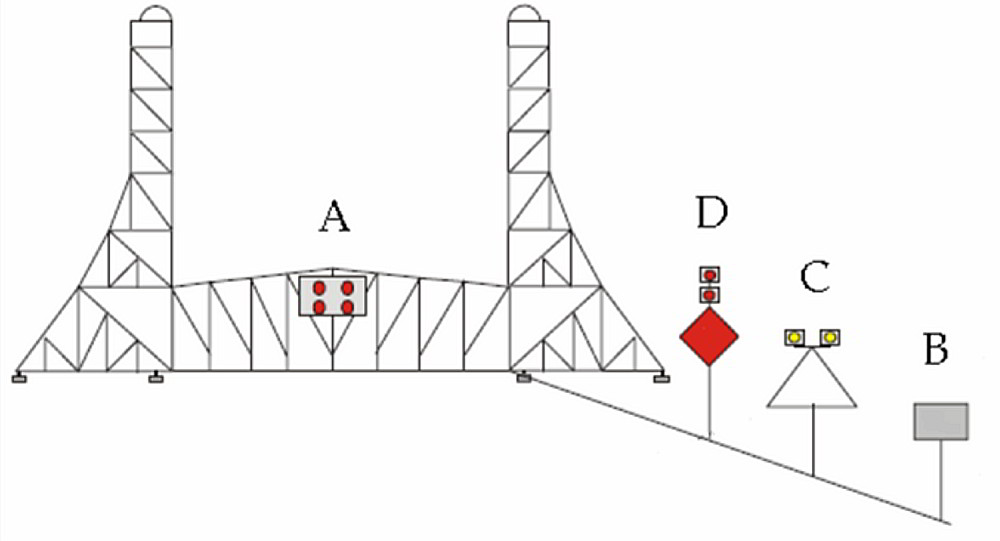Possible bottom contact
Bulk carrier Maccoa
Kahnawake, Quebec
The Transportation Safety Board of Canada (TSB) investigated this occurrence for the purpose of advancing transportation safety. It is not the function of the Board to assign fault or determine civil or criminal liability. This report is not created for use in the context of legal, disciplinary or other proceedings. See Ownership and use of content.
Vessel description
The Maccoa (International Maritime Organization No. 9413913) (Figure 1) is a bulk carrier measuring 185 m long and 23.98 m wideFootnote 1, registered in Cyprus. It was built in 2009 and equipped with a right-hand fixed-pitch propeller and a bow thruster; the latter was non-operational on the day of the occurrence.Footnote 2 In addition to its 2 forward anchors, the vessel has a stern anchor, which is compulsory for vessels transiting the St. Lawrence Seaway. The vessel is owned by TRS Rode B.V. and operated by Navarone S.A.
History of the occurrence
On 06 November 2018, at 0612 Eastern Standard Time,Footnote 3 the Maccoa, loaded with 18 830 tonnes of salt rock in bulk, departed from Montréal, Quebec, for Johnstown, Ontario, under the conduct of a pilot.Footnote 4 The vessel's forward draft was 7.80 m, and its aft draft was 7.83 m.
At 0913, the vessel arrived at the Saint-Lambert Lock, which is located in the South Shore Canal of the St. Lawrence Seaway. In accordance with standard practice, once the vessel arrived at Saint-Lambert Lock, a pilot from the Great Lakes Pilotage Authority replaced the pilot from the Laurentian Pilotage Authority.
At 0935, the vessel left the Saint-Lambert Lock, making speed of about 6 knots as required by St. Lawrence Seaway regulations for vessels navigating along the South Shore Canal.
The Maccoa reached the Côte Sainte-Catherine Lock at 1054 and left the lock at 1120. The pilot and a Seaway traffic controller planned for the vessel to pass Seaway bridges 7A and 7B (Figure 2), which are equipped with lift spans, before 1240, when the next passenger train was scheduled to cross.
At 1144, in anticipation of the Maccoa's arrival at bridges 7A and 7B, a Seaway bridge operator asked a Canadian Pacific Railway (CP) rail traffic controller in Calgary, Alberta, for control of the bridges via their automated control system. Moments later, the Seaway bridge operator realized that bridge control had not been transferred and that the bridge spans were not lifting for the Maccoa. He informed the Seaway traffic controller of the situation.
As required by procedure, the Seaway bridge operator then contacted the rail traffic controller via telephone to clarify the situation and determine why control had not been transferred. The rail traffic controller put the Seaway bridge operator on hold as he attempted to contact the CP contractor performing scheduled rail maintenance on one of the bridge spans that day. The contractor did not immediately respond to the rail traffic controller.
At 1145, the Seaway traffic controller used the very high frequency (VHF) radiotelephone to inform the Maccoa's pilot of the situation. At that time, the Maccoa was 2.06 nmFootnote 5 from the limit of approach sign,Footnote 6 indicated on the nautical chart by a diamond labelled with “L A” (Figure 2), and 2.09 nm from the bridges.
Immediately after the VHF call, the pilot ordered the main engine to slow ahead, quickly followed by dead slow ahead. At about 1146, the pilot gave an order to stop the engine.
With the rudder in amidships position, the vessel moved toward the left side of the canal. To compensate for the movement, the pilot ordered hard to starboard. The ship's bow quickly moved towards the canal's right side. To compensate for that movement and regain control of the vessel, the pilot ordered various emergency manoeuvres using both the rudder and the engine.
Despite these manoeuvres, the vessel continued toward the right side of the canal. At approximately 1150, the pilot ordered full speed astern to avoid running aground.
At 1154, the vessel came close to the navigable limit on the canal's right side. The pilot informed the Seaway traffic controller of the incident, and the crew recorded possible bottom contact in the Maccoa's log book. The crew also verified that there was no water ingress or damage to the vessel.
At approximately 1155, the ship moved toward the centre of the canal.
At 1159, 15 minutes after the Seaway bridge operator's initial request for bridge control, the operator obtained control of Seaway bridges 7A and 7B and was able to raise the 2 bridge spans.
At approximately 1215, the Maccoa passed under Seaway bridges 7A and 7B and continued its voyage to Johnstown.
On 09 November, the vessel's classification society inspected the Maccoa, reporting that the vessel was not damaged in any way and could continue its normal operations.
Environmental conditions
On 06 November, the sky was overcast and visibility was about 10 nm. The wind was from the southeast at 4 knots. The air temperature was approximately 10 °C, and water temperature was 9 °C.
Seaway bridges 7A and 7B
Situated in Kahnawake, Seaway bridges 7A and 7B (Figure 3) span the St. Lawrence Seaway's South Shore Canal. The bridges are equipped with 1 lift span each to allow maritime traffic to pass along the canal. Commuter trains and freight trains use the bridges several times a day. Commuter trains take priority over maritime traffic and cross the bridges according to their predetermined daily schedules, whereas freight trains can be stopped when necessary to allow vessels to pass.
CP and the St. Lawrence Seaway Management Corporation (SLSMC) jointly manage bridge operations for bridges 7A and 7B. Their respective roles and responsibilities are defined in an agreement originally signed by the 2 companies in 1959 and amended in 2016. According to the agreement, each organization must carry out its operations without disruption or delays to the other's services, and when required, CP remotely transfers bridge controls to SLSMC.
The SLSMC is responsible for bridge maintenance, while CP maintains the rail infrastructure. CP typically informs the SLSMC of maintenance jobs on the railway. On the morning of the occurrence, the Seaway bridge operator was informed of a maintenance job on one of the bridge spans for bridges 7A and 7B.
The SLSMC maintains records of bridge malfunctions in its database. In 2018, the SLSMC recorded 11 bridge malfunctions, 2 of which resulted in vessels performing emergency avoidance manoeuvres. None of these incidents were reported to the TSB when they occurred.
St. Lawrence Seaway Management Corporation bridge operations
The SLSMC operates from a centre in Saint-Lambert, which is equipped with several workstations. Each workstation includes several closed-circuit television (CCTV) monitors that display footage from on-site CCTV cameras, as well as computer applications that allow Seaway operators to remotely operate Seaway locks and bridges, ensuring traffic control and site security.
The workstation used to operate bridges 7A and 7B is equipped with a human–machine interface (HMI) screen, as well as several monitors displaying footage from the CCTV cameras installed at the Côte Sainte-Catherine Lock, the bridges, and the canal structure. The workstation also has a direct telephone line to the CP traffic controller (Figure 4).
The Seaway bridge operator for bridges 7A and 7B follows an established procedure to raise the bridge spans. Approximately 30 minutes before a vessel reaches the bridges, the operator requests bridge control from the CP rail traffic controller using the HMI screen. The Seaway bridge operator then contacts the bridges' local security guard via telephone to confirm that nobody is on the lift spans. Once the Seaway bridge operator receives bridge control from CP and confirmation from the security guard that nobody is on the bridges, the operator raises the bridge spans. After the vessel passes the bridges, the operator lowers the bridge spans and returns control to the CP rail traffic controller. The Seaway bridge operator monitors the entire operation on one of the workstation CCTV monitors. Seaway bridge operators must operate only 1 bridge at a time.
If the Seaway bridge operator does not receive control of the bridges within 5 minutes of the initial request, the operator must call the CP rail traffic controller via the direct telephone line to clarify the situation. The operator then calls the Seaway traffic controller to inform the controller of the situation, who in turn informs the vessel so that the vessel can take appropriate action, such as reducing speed.
The Seaway traffic controller uses the VHF radiotelephone to communicate with vessels approaching the bridges.
To provide approaching vessels with information on the status of each bridge, an identical set of signal systems are mounted on either side of each bridge.Footnote 7 These systems consist of navigation lights mounted on each bridge and a set of 3 shore signs at varying distances from the bridge (Figure 5).
Vessels approaching Seaway lift bridges
When a vessel approaches a Seaway lift bridge and the bridge cannot be raised to allow the vessel to pass, the vessel's master or pilot must take appropriate action to avoid passing the limit of approach sign. Typically, the master or pilot will reduce vessel's speed as much as possible while preserving steering capability. In an emergency situation, the master or pilot can drop an anchor. If the vessel is downbound and approaching bridges 7A and 7B, it can stop at the emergency floating dock located 0.25 nm upstream from the bridges.
Factors such as vessel size, momentum, current, the width and depth of the canal, and adverse weather conditions may make it difficult to perform these emergency manoeuvres within the canal.
Previous occurrences
Since 2005, the TSB has investigated 4 occurrences involving Seaway bridges 7A and 7B. Footnote 8
M05C0019 (Federal Sakura) – On 03 June 2005, as the bulk carrier Federal Sakura proceeded upstream toward Seaway bridges 7A and 7B, the vessel's bridge team noted that the signal lights on bridge 7A were still red. The pilot then attempted to contact the bridge operator, but there was no response because the bridge operator had become ill. The decision was made to stop the vessel under the Honoré-Mercier Bridge, downstream from bridges 7A and 7B. There was no headway, but the stern of the vessel brushed against the south pier of the Honoré-Mercier Bridge.
M09C0067 (Spruceglen), M10C0087 (CSL Assiniboine), and M11C0039 (Utviken) – In these occurrences, the Seaway bridges' spans did not rise, and the vessels took evasive emergency manoeuvres to avoid a collision.
Between October and December 2018, the TSB received reports of 4 other incidentsFootnote 9 where vessels took emergency evasive manoeuvres when the lift spans of Seaway bridges 7A and 7B did not rise.
This report concludes the Transportation Safety Board of Canada's investigation into this occurrence. The Board authorized the release of this report on 31 July 2019. It was officially released on 16 August 2019.
